
Everyone visiting Madrid who is only remotely interested in art will have a look at one or two, or possibly more of the numerous art museums of the city. The most famous one is of course the Prado. It was established at the beginning of the 19th century by the Spanish king Ferdinand VII, who was jealous of the French who had the already famous Louvre in Paris. The Prado collection covers the whole spectrum of European painting up to the 20th century, but is most famous for Spanish painters like Velásquez, el Greco (named thus because he was originally from Greece), who lived in Toledo for the better part of his life, and Goya. With more than 1000 artworks on display you would need at least a week to have a proper look at all of them.

Apart from the paintings, we were especially taken by the new extension, which star architect Rafael Moneo designed for the Prado. In order to erect a new multi-floor and partly underground exhibition space adjacent to the old building, the cloister of the neighbouring monastery had to be torn down, but is rebuilt in the upper floor and skilfully integrated into the exhibition.
The Centro del Arte Reina Sofia

Artwork by Roy Lichtenstein in the courtyard of the Reina Sofia Museum
The other must-see museum in Madrid is the Centro del Arte Reina Sofia, whose most famous piece of art is „Guernica“ by Pablo Picasso. It was commissioned by the Spanish Republican Government for the World Exhibition in Paris in summer 1937, i.e. during the Spanish Civil War. In March Picasso hadn’t even started painting, perhaps not even considered the design. On 26 April, the Basque town of Guernica, a civilian stronghold of the Republican Resistance against the Franco troops, was bombed by German planes in support of the Franco regime. Because the bombing came without any warning, there were no journalists or photographers in town to cover the tragedy. So Picasso painted his Guernica picture as a symbol of remembrance. With the end of the Civil war in Spain and the victorious Franco regime taking over the government, the painting was sent to the United States to raise funds in support of the Spanish refugees. At Picasso’s request it was entrusted to the Museum of Modern Art in New York City. And there it stayed, because the painter refused to allow it returned to Spain during the years of dictatorship. It was finally returned in 1981 after the death of both Franco and Picasso. While Guernica might be the main draw to visit the Museo Reina Sofia, again one could spend hours with the pictures of famous 19th and 20th century artists.

The Thyssen -Bornemisza Collection
The third big museum in Madrid is the Thyssen-Bornemisza Collection. It presents the superb art collection of the Thyssen-Bornemisza family originally housed in their family estate in Lugano. The ever growing collection, the scarce space in the family estate and a new Spanish wife finally led to the relocation of the family, together with the core of their paintings, to Spain, where a building near the Prado museum was conveniently available. The collections has a little bit of everything, mediaeval and Renaissance paintings as well as works from the Dutch, English and German schools. Also the Impressionists, the Expressionists, and the European and American paintings from the second half of the 20th century are quite worth seeing.
Museums in the Golden triangle of art
A collective ticket for all three museums, at 26 €, saves you 6 € if you see all three.
Prado www.museodelprado.es/en/
Museo Centro de Arte Reina Sofia www.museoreinasofia.es/en
El Museo der Arte Thyssen Bornemisza www.museothyssen.org/en/thyssen/home



